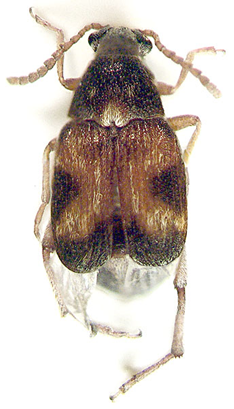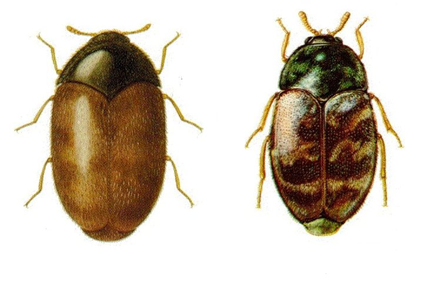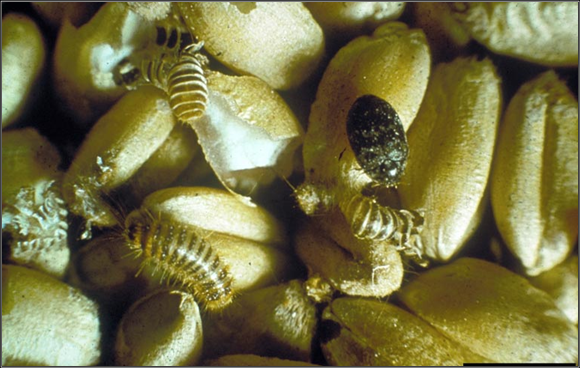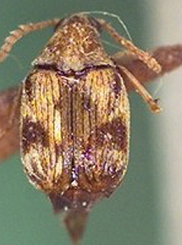Insects - chickpea
Contributors to this page: ICRISAT, India (RP Thakur, AG Girish, VP Rao); ICARDA, Syria (Siham Asaad, Abdulrahman Moukahal).
|
Contents: |
Scientific name
Callosobruchus analis Fabricius.
Other scientific names
Bruchus analis, Bruchus glaber, Bruchus jekelii, Bruchus obliquus, Bruchus ciceri,
Callosobruchus glaber, Callosobruchus jekelii.
Importance
Medium.
Significance
Infested chickpea lose their viability and are unfit for human consumption. In Africa, Asia, and Oceania, C. analis is considered a pest of economic importance for stored-legume grains (Southgate 1979).
Symptoms
Chickpea pods are seldom infested in the field. The pests attack nearly mature and dried pods during storage. The round exit hole and the white eggs on the pod wall are clearly visible. Infested stored seed can be recognized by the eggs on the seed surface and the round exit holes with the ‘flap’ of seed coat.
|
Stored Grain Pest (photo:www.invasive.org) |

Damaged grains with white eggs and floppy windows (photo: ICRISAT) |
Hosts
Cicer arietinum (chickpea), Cajanus cajan (pigeonpea) and other grain legumes.
Geographic distribution
Callosobruchus analis is widespread in Asia.
Biology and transmission
Adults are small, 3 mm long brown beetles with black spots on the elytra. Eggs are laid on the seed surface. Larvae feed and pupate entirely within the seed. One generation is completed in 4-5 weeks (Ranga Rao and Shanower 1999).
Detection/indexing methods used in CGIAR
- At ICRISAT - Dry seed examination and X-ray radiography are used for detection of the bruchides.
- At ICARDA - Visual and microscopic inspection.
Treatment/control
-
At ICRISAT
- Fumigation with methyl bromide by 32 g/m3 for 4 hrs followed by seed treatment with chlorpyriphos 3 g/kg-1 seed (Ghanekar et al. 1996).
-
At ICARDA
- Cleanliness in storage: stores should be cleaned from all residues of grains, straw and flour and be de-infested by spraying walls with malathion,
- Sacks, thresher and transportation vehicles also should be cleaned.
- Seeds stored for food/feed can be fumigated with phospine (Phostoxine). Seeds stored for planting can be treated with insecticides such as Actellic at 4-10 ppm a.i. (0.5 g/kg seed) or malathion at 10 ppm a.i., which will protect the seeds for several months.
Procedures in CGIAR in case of positive test
- At ICRISAT - Removal of the infested seeds followed by the seed treatment with chloropyriphos at 3 g/kg-1 seed.
- At ICARDA - Fumigation.
References and further reading
Chakrabarty SK, Anitha K, Girish AG, Sarath Babu B, Prasada Rao RDVJ, Varaprasad KS, Khetarpal RK, Thakur RP. 2005. Germplasm exchange and quarantine of ICRISAT mandate crops. Information Bulletin No. 69. Rajendranagar 500 030, Andhra Pradesh, India: National Bureau of Plant Genetic Resources; and Patancheru 502 324, Andhra Pradesh, India: International Crops Research Institute for the Semi Arid Tropics. 80pp.
Ghanekar AM, Ranga Rao GV, Murthy KS, Surender A, Shaik Babu Saheb. 1996. Seed protectants for healthy exports. Indian Journal of Plant Protection 24: 37-43.
Ranga Rao GV, Shanower TG. 1999. Identification and Management of Pigeonpea and Chickpea Insects Pests in Asia. Information Bulletin No. 57, Patancheru, 502 324, A.P., India: International Crops Research Institute for the Semi Arid Tropics. 96pp.
Southgate BJ. 1979. Biology of the Bruchidae. Annual Review of Entomology 24:449-473.
Cowpea seed beetle, Adzuki bean seed beetle
Scientific names
Callosobruchus maculatus (Fabricius), 1775;
and
C. chinensis (L.), 1758.
Significance
The Callosobruchus beetles are principally a serious pest of products stored under hot dry conditions; complete destruction of grain and pulses may occur in a short time. In humid climates, the its competitors are so much greater that it has difficulty in establishing itself.
Symptoms/damage
At the larval stage the beetles tunnel into and develop within the beans. They may consume nearly the entire bean content. Pupation occurs within the beans and adults emerge through a round hole in the seed coat. Damage is caused by a combination of the feeding and contamination.
Hosts
The Callosobruchus beetles attack several legumes in storage, chickpea (Cicer arietinum), arhar (Cajanus cajan), green gram (Vigna radiata), pea (Pisum sativum) and kidney bean (Phaseolus vulgaris) seeds. On lentil, C. chinensis is the most common.
Geographic distribution
Both species are widespread and found in all continents with subtropical or tropical conditions (USA, Mediterranean, India and Australia).
Biology and transmission
The eggs are glued to the bean or the pod. On hatching the larvae bores into the seed where it makes a translucent 'window' in the seed before pupating. The larval and pupal stages are spent inside the bean. The adult emerges through the 'window' leaving a neat round hole. Infestations can begin in the field. Adults move to bean fields from trash beans left in sacks, harvesters, planters, or feed areas. The cowpea weevil readily attacks dried beans; thus this weevil can be a serious storage pest. Bean weevil infestations can also start in the field and may also originate from trash beans. As with the cowpea weevil, the bean weevil will attack dried beans and can be a serious pest in stored beans. Broad bean weevil infestations also start in the field, but this pest is not a storage problem.
Detection/indexing methods in place at the CGIAR Centres
- At ICRISAT - Dry seed examination and X-ray radiography are used for detection of the bruchides.
- At ICARDA -Visual and microscopic inspection.
Treatment/control
-
At ICRISAT
- Fumigation with methyl bromide by 32 g/m3 for 4 hr followed by seed treatment with chlorpyriphos 3 g/kg-1 seed.
-
At ICARDA
- Cleanliness in storage: stores should be cleaned from all residues of grains, straw and flour and be de-infested by spraying walls with malathion; sacks, thresher and transportation vehicles should also be cleaned.
- Seeds stored for food/feed can be fumigated with phospine (Phostoxine). Seeds stored for planting can be treated with insecticides such as Actellic at 4-10 ppm a.i. (0.5 g/kg seed) or malathion at 10 ppm a.i., which will protect the seeds for several months.
Procedures in place within the CGIAR Centres in case of positive test
- At ICRISAT - Removal of the infested seeds followed by seed treatment with chloropyriphos at 3 g/kg-1 seed.
- At ICARDA - Fumigation.
References and further reading
http://www.icarda.org/Publications/Field_Guides/Lentil/Lentil.htm#Lent7.Html
http://www.infonet-biovision.org/default/ct/82/pests
http://agspsrv34.agric.wa.gov.au/Ento/pestweb/Query1_1.idc?ID=-1771861620
http://www.zin.ru/Animalia/coleoptera/rus/calmacdk.htm
http://www.infonet-biovision.org/default/ct/82/pests
 |
 |
|
|
Callosobruchus maculatus (photo: infonet-biovision.org) |
||
Scientific name
Trogoderma granarium Everts.
Other scientific names
Trogoderma afrum, Trogoderma khapra, Trogoderma quinquefasciata.
Importance
High.
Significance
Trogoderma granarium is a serious pest of stored products under hot dry conditions. Established infestations are difficult to control because of the beetle's ability to live without food for long periods of time and to survive on foods of low moisture content, its habit of crawling into tiny cracks and crevices and remaining there for long periods, and its relative tolerance to many surface insecticides and fumigants.
Symptoms
The Khapra beetle is one of the world's most feared stored product pests. The obvious signs of a Khapra beetle infestation are the larvae and cast skins. Larvae and adults are best identified by microscopic examination. Larvae are most likely to be seen just before dusk, since they are more active at that time (Anonymous 1981).
 Khapra beetle (from: agspsrv34.agric.wa.gov.au) |
Host
Larvae feed on a wide variety of stored products and dried foods. They prefer whole grain and cereal products such as Triticum aestivum (wheat), Hordeum vulgare (barley), and Oryza sativa (rice), but larvae have been recorded on the following: Avena spp. (oats)), Secale spp. (rye), Zea mays (corn), dried blood, dried milk, fishmeal, Arachis hypogea (ground nuts), flour, bran, malt, Linum usitatissimum (flax seed), Medicago sativa (alfalfa seed), Lycopersicum esculantus (tomato seed), Phaseolus vulgaris (pinto beans), Vigna unguiculata (blackeyed cowpeas), Sorghum bicolor (sorghum seed) and many other food products (Lindgren and Vincent 1959; Lindgren et al. 1955).
Geographic distribution
The distribution of khapra beetle extends from Mayanmar (Burma) to West Africa and is limited by the 35° parallel to the north and the equator to the south. It has been introduced by commerce into some areas of similar climatic conditions (Anonymous 1981). The Khapra beetle is found in all continents where grain and grain products are stored.
Biology and transmission
The adults are oblong-oval beetles, approximately 1.6 to 3.0 mm long and 0.9 to 1.7 mm wide. Males are brown to black with indistinct reddish-brown markings on elytra. Females are slightly larger than males and lighter in colour. The head is small and deflexed with a short 11-segmented antenna. The antennae have a club of three to five segments, which fit into a groove in the side of the pronotum. The adults are covered with hairs. The eggs are milky white, turning pale yellow with age, cylindrical, 0.7 0.25 mm, one end rounded, the other pointed and bearing spine-like projections. Larvae are uniformly yellowish-white, except head and body hairs that are brown. As the larvae increase in size, their body colour changes to a golden or reddish-brown, more body hairs develop, and the tail becomes proportionally shorter. Mature larvae are approximately 6 mm long and 1.5 mm wide. Adult Khapra beetles have wings, but apparently do not fly and feed very little. Mated females live from four to seven days, unmated females from 20 to 30 days, and males from 7 to 12 days. Mating occurs about five days after emergence, and egg laying begins almost immediately at 40°C. Egg laying may begin at one to three days at cooler temperatures, but no eggs are produced at 20°C. Eggs hatch in 3 to 14 days after the female lays an average of 50 to 90 eggs that are loosely scattered in the host material. Complete development from egg to adult can occur within 26 to 220 days, depending upon temperature. Optimum temperature for development is 35°C. If the temperature falls below 25°C for a period of time or if larvae are very crowded, they may enter diapauses. They can survive temperatures below -8°C. In diapauses, the larvae can moult but are inactive and may remain in this condition for many years (Anonymous 1981).
 Larvae of Trogoderma granarium and damaged grains (photo: agspsrv34.agric.wa.gov.au) |
Detection/indexing methods used in the CGIAR Centres
- At ICRISAT - Dry seed examination using magnifying lens.
Treatment/control
High concentrations of fumigant (Aluminium phosphide) are maintained during the fumigation period to allow penetration into all cracks and crevices. In an eradication programme, both fumigants and surface treatment (chloropyriphos) are used in combination with preventive measures, e.g., good sanitation practices and exclusion.
Procedure followed in the CGIAR Centres in case of positive test
- At ICRISAT - Rejection and incineration of the infested seed samples.
EPPO protocols
EPPO A2 list: No.121.
Control. Methyl bromide fumigation gives good control for a wide range of commodities. Effective control in the structure of buildings and ships requires high concentrations maintained over the fumigation period to enable the gas to penetrate into cracks and crevices. A list of dosage schedules may be found in EPPO quarantine procedure No. 12 (OEPP/EPPO 1982). Phosphine can also be used against T. granarium; dosage schedules are given by OEPP/EPPO (1984). In India, the use of deoiled neem (Azadirachta indica) seed powder mixed into wheat was found to be an effective and cheap method to control the pest in stored wheat (Singh and Kataria 1986). The use of carbon dioxide was also reported to be effective in India (Srivastava 1985). As an alternative to the fumigation of cereals with methyl bromide or other pesticides, the use of a heat treatment has been reported to be very effective against the Khapra beetle (Fleurat-Lessard 1985). An exposure to 60°C for 30 min resulted in 100% mortality of all stages of T. granarium (Ismail et al. 1988).
Phytosanitary risk. T. granarium is an A2 quarantine organism for EPPO (OEPP/EPPO 1981), and is also of quarantine concern for CPPC, COSAVE, JUNAC, NAPPO and OIRSA. The continued occurrence of T. granarium on produce imported from countries where it is indigenous, and the potential for spread due to increasing use of dry cargo containers and roll-on roll-off road transport, make it a continued threat to EPPO countries. This not only applies to the risk of establishment in heated buildings in areas of unfavourable climate, but also to parts of Greece, Italy, Spain and Russia on the fringes of the natural range, where it is not known to be established. A minimum period of four months with an average temperature of 20°C is considered necessary for T. granarium to be a threat. In addition, it should be recalled that other continents take severe measures against T. granarium; the presence of the pest in an EPPO country would be a significant additional constraint to its export.
Phytosanitary measures. EPPO (OEPP/EPPO 1990) recommends that it is preferable not to require a Phytosanitary Certificate for stored products, but rather to inspect consignments on import and take appropriate post-entry action, for example treatment following EPPO Quarantine Procedures Nos 12 or 18 (OEPP/EPPO 1982; 1984).
References and further reading
Anonymous. 1981. Data sheets on quarantine organisms. Trogoderma granarium Everts. European and Mediterranean Plant Protection Organization Bulletin 11 (1) Set 4, List A2, 1-6 pp.
Fleurat-Lessard F. 1985. Les traitements thermiques de desinfestation des cereals et des produits céréaliers: possibilité d'utilisation pratique et domaine d'application. Bulletin OEPP/EPPO 15:109-118.
Ismail AY, Abid SH, Mawlood N.A. 1988. Effect of high temperature on the mortality of the red flour beetle Tribolium confusum and khapra beetle Trogoderma granarium. Zanco 1:35-42.
Lindgren DL, Vincent LE. 1959. Biology and control of Trogoderma granarium Everts. Journal of Economic Entomology 52:312-319.
Lindgren DL, Vincent LE, Krohne HE. 1955. The khapra beetle, Trogoderma granarium Everts. Hilgardia 24:1-36.
OEPP/EPPO. 1990. Specific quarantine requirements. EPPO Technical Documents No. 1008.
OEPP/EPPO. 1984. Quarantine procedures No.18. Phosphine fumigation of stored products. Bulletin OEPP/EPPO Bulletin 14:598-599.
OEPP/EPPO. 1982. Quarantine procedures No.12. Methyl bromide fumigation of stored products. Bulletin OEPP/EPPO Bulletin 12 (Special issue on EPPO recommendations on fumigation standards): 30-31.
OEPP/EPPO. 1981. Data sheets on quarantine organisms No. 121, Trogoderma granarium. Bulletin OEPP/EPPO Bulletin 11(1).
Singh RP, Kataria PK. 1986. Deoiled neem kernel powder as protectant of wheat seeds against Trogoderma granarium Everts. Indian Journal of Entomology 48:119-120.
Srivastava JL. 1985. Use of controlled atmosphere for the control of stored product insects. In: Behavioural and physiological approaches in pest management (Ed. by Regupathy, A.; Jayaraj, S.), pp. 202-207. Coimbatore, Tamil Nadu, India.
Comments
- No comments found






Leave your comments
Post comment as a guest